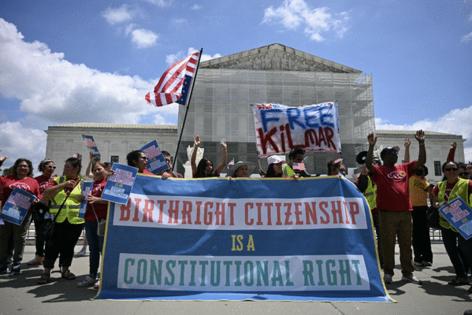The Supreme Court decision on birthright citizenship: What you need to know
Published in News & Features
The U.S. Supreme Court on Friday issued a major decision scaling back the power of federal judges to block presidential policies nationwide, in what is considered a major win for the Trump administration’s efforts to end birthright citizenship for children born in the U.S. to undocumented immigrants and foreign visitors.
The high court, however, stopped short of ruling on the constitutionality of the controversial order itself.
Here’s what you need to know about the decision and what it means going forward.
Q: What exactly did the Supreme Court decide?
A: In a 6–3 ruling, the justices limited the use of nationwide injunctions — broad court orders that block a federal policy across the entire country while legal challenges play out in court. The ruling effectively narrowed the impact of decisions by lower court judges in Maryland, Washington state and Massachusetts that had temporarily blocked former President Donald Trump’s executive order ending automatic citizenship for children born to undocumented immigrants and certain visa holders.
Those lower court rulings now apply only in their respective jurisdictions, rather than nationwide. The case now returns to those courts for further consideration.
Q: What is birthright citizenship, and why is it so important?
A: Birthright citizenship is the principle, enshrined in the 14th Amendment, that anyone born on U.S. soil is automatically a U.S. citizen — with the only exceptions being children of foreign diplomats. This guarantee was ratified after the Civil War to ensure citizenship for formerly enslaved people and has been upheld repeatedly by the courts, most notably in the 1898 landmark case of Wong Kim Ark, which affirmed that a child born in the U.S. to Chinese immigrants was a citizen.
Trump’s order challenges that principle by arguing that undocumented immigrants are not “subject to the jurisdiction” of the U.S., and thus their children don’t qualify for automatic citizenship — an interpretation most legal scholars call radical and unfounded.
Q: Did the Supreme Court rule on whether Trump’s executive order is constitutional?
A: No. The justices did not decide on the constitutionality of the executive order itself. The court focused only on the procedural question of whether lower courts overstepped by issuing nationwide injunctions. The underlying legal battle over the birthright citizenship order will continue in lower courts.
Q: Could Trump’s order go into effect now?
A: Not immediately. The Supreme Court delayed the order from taking effect for 30 days, giving lower courts time to review its implementation. However, because the nationwide injunctions were vacated, the order could be enforced in states, like Florida, where legal challenges haven’t been filed — creating geographic inconsistencies and potentially prompting new lawsuits.
Q: What’s at stake for families?
A: A great deal. If Trump’s policy ultimately stands, children born in the U.S. whose parents are undocumented immigrants or visa holders could be left stateless, denied passports, Social Security numbers and access to education or employment. In states like Florida, where over half a million undocumented residents live, researchers estimate 280,000 children have at least one undocumented parent. These families face profound uncertainty about their children’s future.
Q: What was the Trump executive order about?
A: On his first day back in the White House, Trump signed an executive order aimed at ending birthright citizenship for children born in the U.S. to undocumented immigrants and temporary visa holders. The order instructed federal agencies not to grant passports or official documents to such children — a dramatic break from over 150 years of legal precedent.
Q: Why did the Trump administration want to eliminate nationwide injunctions?
A: The administration argued that these injunctions give too much power to individual judges, allowing them to halt federal policies nationwide even before a full legal review. In court filings, Justice Department attorneys said the use of universal injunctions had reached “epidemic proportions,” and claimed they interfere with the executive branch’s ability to govern.
The Supreme Court’s majority opinion, written by Justice Amy Coney Barrett, found that federal judges don’t have sweeping authority to stop an executive order nationwide because Congress did not grant the courts that power under the 1789 Judiciary Act.
Q: What did the dissenting justices say?
A: Justice Sonia Sotomayor, joined by two other liberal justices, strongly dissented. She called the ruling a “travesty” that would “cause chaos for the families of all affected children.” Sotomayor emphasized that removing nationwide injunctions risks creating a patchwork of rights, where children born in some states may be considered citizens while others are not — leading to uncertainty, confusion, and possible constitutional violations.
Q: What happens next?
A: The legal fight over the executive order is far from over. The ruling sends the case back to the district courts in Maryland, Washington state, and Massachusetts, where the core issue — whether Trump’s order violates the 14th Amendment — will be argued.
Depending on those outcomes, the case may return to the Supreme Court, which could eventually decide the constitutionality of ending birthright citizenship for children born in the U.S. to undocumented immigrants and visa holders — a ruling that would have profound consequences for immigration and civil rights.
Q: What are the broader implications of this ruling?
A: The decision may significantly limit how policies are challenged in federal courts. In recent years, federal judges have used nationwide injunctions to halt a range of controversial actions, from Trump’s travel ban to Biden-era regulations on climate and immigration. Now, individual lawsuits may only apply to the plaintiffs or their specific states or organizations — unless a class action is certified.
This could make it harder and slower for challengers to block federal policies, especially in urgent cases, and potentially increase litigation across different jurisdictions.
Q: What do polls say about Trump’s birthright citizenship order?
A: While Trump’s tough stance on immigration has energized his base, polls suggest that most Americans oppose the effort to eliminate birthright citizenship. A recent Pew Research Center survey found that 56% of Americans disapprove of the executive order, compared to 43% who support it.
Critics say the move undermines a core principle of American democracy and reflects a broader push to redefine constitutional rights. Supporters argue it is necessary to deter undocumented immigration.
Q: What’s next for the courts — and for Trump’s immigration agenda?
A: The lower courts will now evaluate whether Trump’s order is constitutional. If they rule against it, the administration is likely to appeal, setting up another potential showdown at the Supreme Court.
Meanwhile, Trump continues to reshape U.S. immigration policy, using executive orders to fast-track deportations, suspend refugee admissions, and end legal protections for hundreds of thousands of migrants — all of which could be affected by Friday’s ruling on the limits of judicial power.
_____
©2025 Miami Herald. Visit miamiherald.com. Distributed by Tribune Content Agency, LLC.







Comments